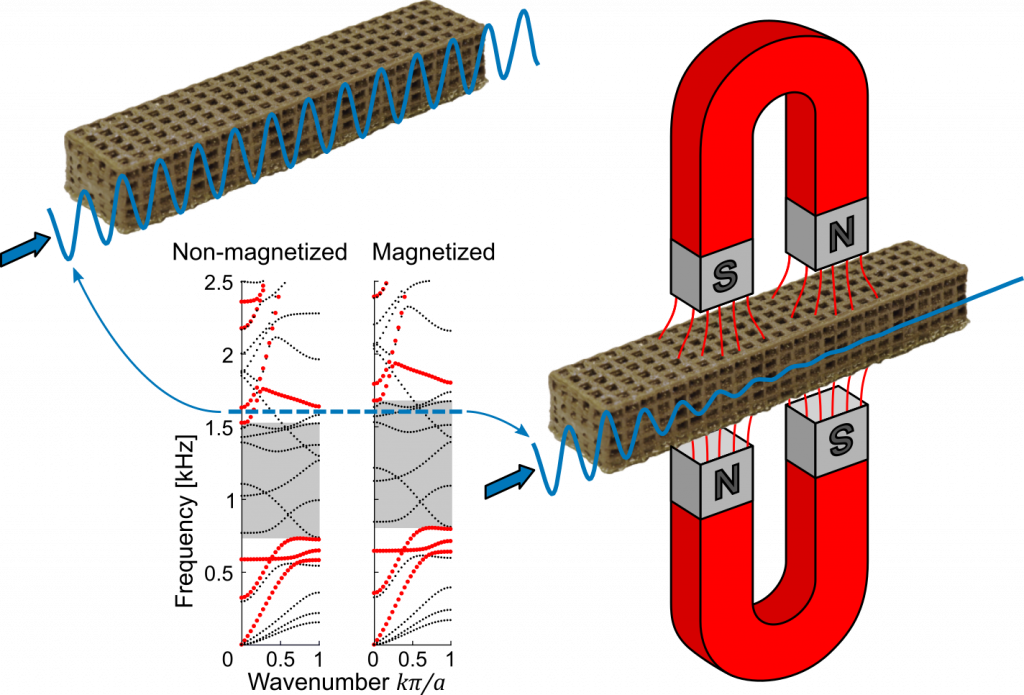Lattice-based metastructures afford a great deal of flexibility in the design of phononic systems because they have many geometric parameters that can be judiciously selected to create band gaps in desired frequency ranges. However, lattice-based metastructures still suffer from a key limitation, namely, that their band gaps are fixed at design time by the chosen geometry and material properties. For many systems, particularly those that are subjected to multiple different operating regimes, it is desirable to have metastructures with band gaps that can be controlled on-the-fly. To develop such tunable metastructures, we are studying how tunable stiffness materials, e.g. the thermally-dependent moduli of polymers [Nimmagadda and Matlack, J. Sound Vib. 2019] and the magneto-mechanical coupling in magneto-active elastomers [Pierce et al., Smart Mater. Struct. 2020], can be used to tune wave propagation in metastructures.
Thermo-Responsive Metastructures
Using finite element method (FEM) simulations, we showed that band gaps in polymer-based metastructures can be tuned by applying different temperatures, taking advantage of the temperature-dependent modulus of polycarbonate. Interestingly, we found that they can be opened and closed by preferentially selecting the temperature of different geometric components in the unit cell [Nimmagadda and Matlack, J. Sound Vib. 2019].
Magneto-Active Metastructures
To further study tunable band gaps using tunable-stiffness materials, we fabricated metastructures from magneto-active elastomers (MAE), through a collaboration with the Air Force Research Lab. MAEs are “smart” composite materials consisting of iron particles embedded in an elastomer matrix, and have a stiffness that can be tuned by application of a magnetic field. Using experimental (additive manufacturing and vibration testing of MAE metastructures) and computational approaches (multi-physics FEM simulations), we showed the elastic-wave band gaps in MAE metastructures can be tuned over a continuous frequency range through the application of a magnetic field. A surprising finding was that the band gap tunability not only depends on the strength of the magnetic field, but it also depends on the interaction of the magnetic field with the metastructure geometry. Specifically, the magnitude of the frequency shift can be controlled by the strength and “shape” of the magnetic field and the metastructure geometry. This demonstrated a new parameter in the design space for customizable control of band gap frequency ranges, where the magnetic tunability of the band gaps enables active control of elastic waves via remote stimulation [Pierce et al., Smart Mater. Struct. 2020]. These results have applications in smart structures with integrated adaptive vibration control.
Journal Publications:
C. D. Pierce, K. H. Matlack, “Fuzzy Band Gaps”: A Physically Motivated Indicator of Bloch Wave Evanescence in Phononic Systems. Crystals, vol. 11(1), 66 (2021). https://doi.org/10.3390/cryst11010066
C. D. Pierce, C. L. Willey, V. W. Chen, J. O. Hardin, J. D. Berrigan, A. T. Juhl, K. H. Matlack, Adaptive elastic metastructures from magneto-active elastomers. Smart Materials and Structures, vol. 26(9), 065004 (2020). https://doi.org/10.1088/1361-665X/ab80e4
C. Nimmagadda, K. H. Matlack, Thermally tunable band gaps in architected metamaterial structures. Journal of Sound and Vibration, 439, pp.29–42 (2019). https://doi.org/10.1016/j.jsv.2018.09.053
Conference Presentations:
C. D. Pierce*, K.H. Matlack, “Fuzzy band gaps”: quantifying Bloch wave evanescence in viscoelastic phononic crystals. The Virtual Meeting 2020 of the Society of Engineering Sciences (2020)
C. D. Pierce*, V. W. Chen, C. L. Willey, J. O. Hardin, A. T. Juhl, J. D. Berrigan, K.H. Matlack, “Computational Investigation of Magnetoactive Elastomers for Tunable Vibrational Metamaterials”, US National Conference of Computational Mechanics, July 28 – Aug. 1, 2019, Austin, TX
C. D. Pierce*, V. O. Chen, C. L. Willey, J. O. Hardin, A. T. Juhl, J. D. Berrigan, K. H. Matlack, “Viscoelastic effects on the frequency response of elastomeric metastructures”, SPIE Smart Structures and Nondestructive Evaluation, Mar. 3-7 2019, Denver, CO
C. D. Pierce*, V. O. Chen, C. L. Willey, J. O. Hardin, A. T. Juhl, J. D. Berrigan, K. H. Matlack, “3D Printed Magnetorheological Elastomer Metastructures with Magnetically-Tunable Band Gaps”, International Mechanical Engineering Congress & Exposition (IMECE), Nov. 9-15, 2018, Pittsburgh, PA

